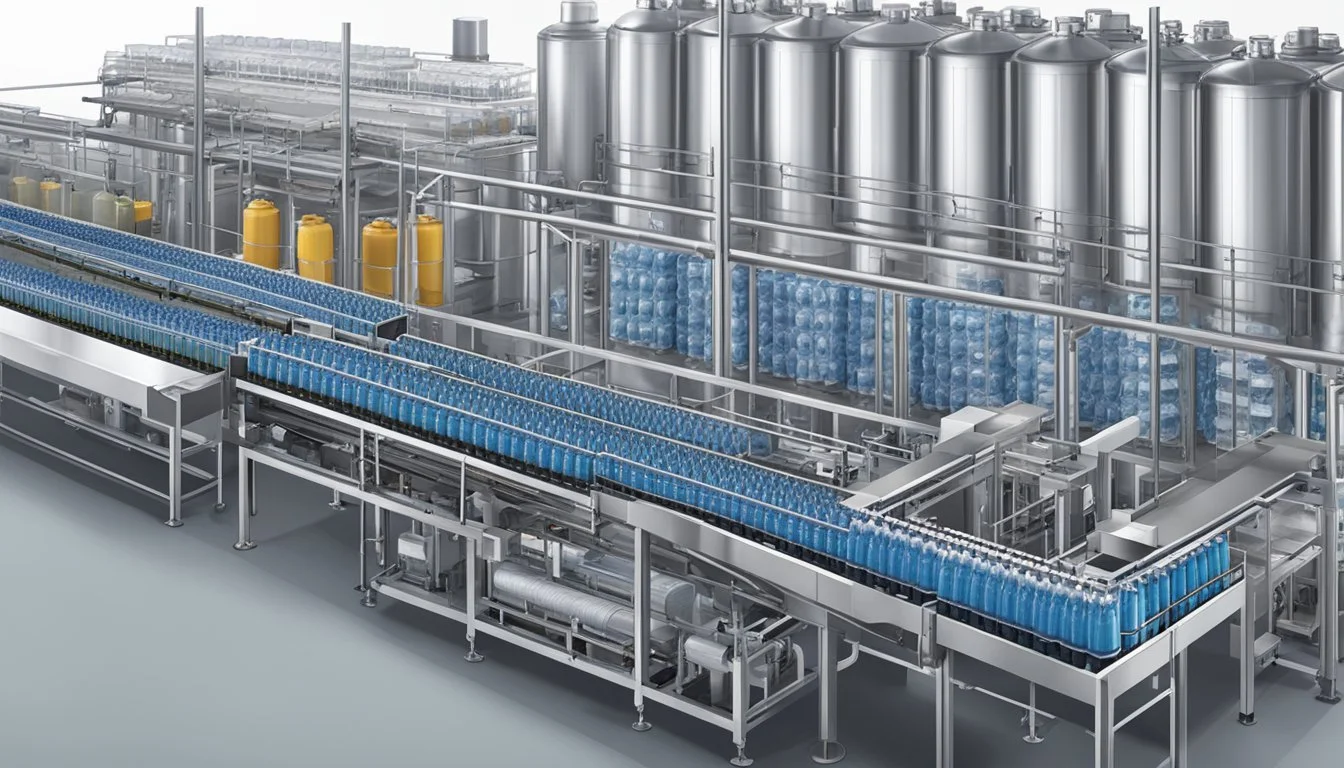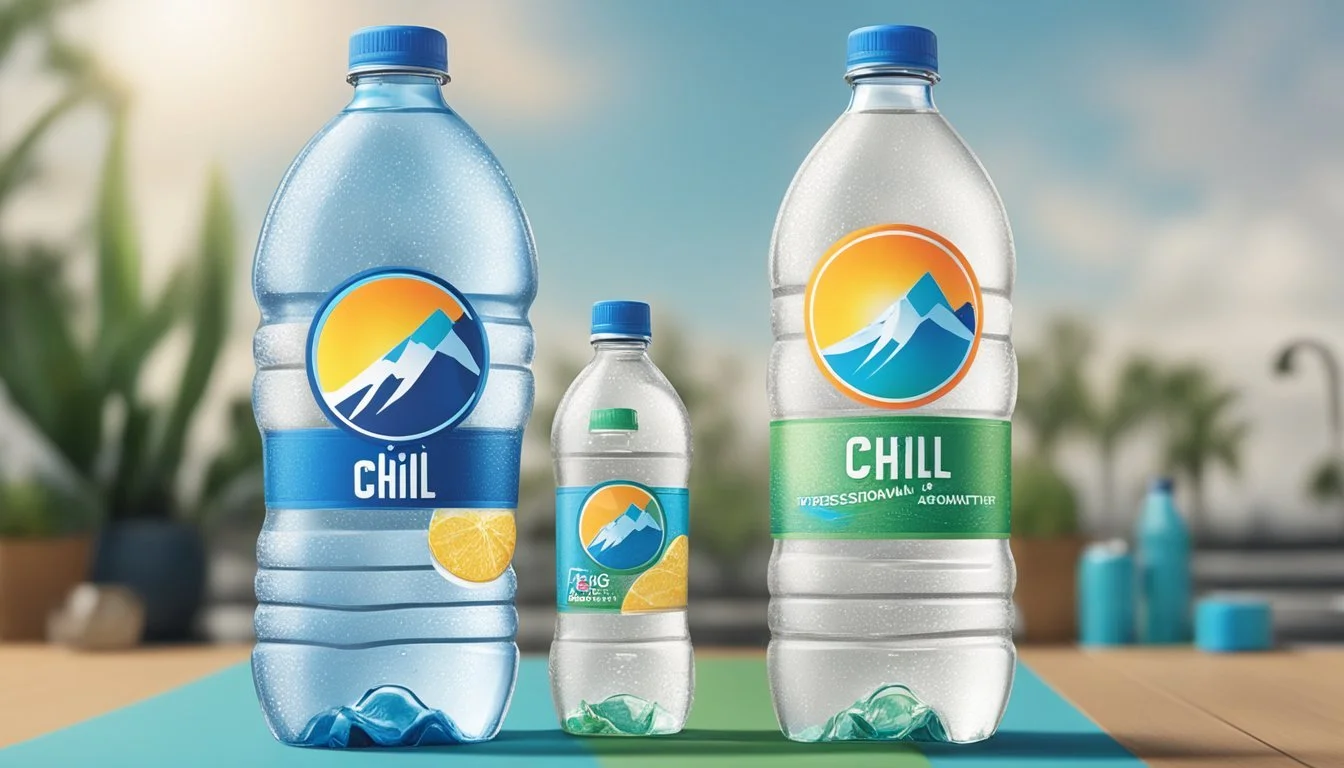Big Chill vs. Action
A Detailed Comparison of Bottled Water Brands
Choosing the right bottled water can be a matter of preference and necessity. Two popular brands, Big Chill and Action, offer different qualities that might cater to varied tastes and needs. Big Chill, distributed by CVS, has a neutral profile making it a reliable choice for those who prefer a taste without strong aftertastes. On the other hand, Action water is known for its high pH level, which some enthusiasts believe offers better hydration and balance for the body.
For consumers who prioritize a neutral taste without noticeable additives, Big Chill stands out as a solid option. Unlike some other brands, Big Chill's simplicity appeals to those wanting hydration without any additional flair. Its purity and clean taste make it a favorite for everyday consumption.
Action water sets itself apart with its alkalinity. With a higher pH, Action is marketed towards those looking for potential health benefits associated with alkaline water. Although the body's natural mechanisms are quite efficient at maintaining pH balance, the perceived benefits of alkaline water keep it popular among health-conscious individuals.
Water Fundamentals
When choosing between bottled waters like Big Chill and Action, understanding the basics of hydration, the sources of drinking water, and the taste profiles is paramount. By examining these elements, readers can make more informed decisions about their preferred bottled water brand.
Understanding Hydration
Hydration is crucial for maintaining bodily functions such as temperature regulation, digestion, and joint lubrication. Proper hydration impacts energy levels, cognitive function, and overall health.
Water, a vital component of hydration, works by aiding in nutrient transport and waste elimination. The daily recommended water intake can vary, but a general guideline is eight 8-ounce glasses. While this varies based on activity level and climate, ensuring consistent water intake is essential.
Sources of Drinking Water
Drinking water can come from various sources including tap water, mineral water, and spring water. Tap water is typically sourced from surface water or groundwater and is treated to meet safety standards. It is cost-effective and readily available.
Mineral water originates from mineral springs and contains dissolved minerals like calcium, magnesium, and sodium, which can be beneficial for health. Spring water comes from underground springs and is often bottled at the source, retaining natural minerals.
The choice between these depends on factors such as cost, convenience, and preferred mineral content. While tap water is inexpensive and accessible, bottled water options like mineral and spring water may offer unique health benefits.
Taste Profiles of Water
The taste of water can vary significantly based on its source and mineral content. Tap water may have varying flavors depending on the treatment process and local minerals present. It is usually consistent but can pick up slight flavors from pipes.
Mineral water often has a distinct taste due to the concentration of dissolved minerals, which can add subtle flavors. Spring water might have a fresh, clean taste, reflecting its natural source.
Consumers often choose their water based on taste preferences, influenced heavily by the natural or added minerals. A blind tasting of different water types can reveal surprising preferences and perceptions regarding taste.
Comparing Bottled Water Brands
Big Chill and Action are two popular bottled water brands with distinct differences in their nutritional content, flavor, and overall consumer appeal. This section examines these aspects to provide clarity on which brand might be the better choice for different preferences.
Big Chill vs. Action: Overview
Big Chill is known for its pure and clean taste, often sourced from natural springs. It aims to provide a refreshing drinking experience with minimal additives. Action, on the other hand, focuses more on performance and functionality, often enhanced with electrolytes and minerals to support hydration during physical activities.
Consumers might prefer Big Chill for its simplicity and natural taste. Action could be more suitable for those needing enhanced hydration support due to its mineral and electrolyte content. Both brands cater to different needs and preferences.
Nutritional Content Analysis
Big Chill typically boasts a low mineral content, emphasizing its pure, unaltered nature. This makes it ideal for those seeking plain, non-enhanced bottled water without any additional elements. It often highlights its natural spring sources to appeal to consumers seeking authenticity.
Action, however, includes added electrolytes such as sodium, potassium, and magnesium, enhancing its hydrating properties. This is particularly beneficial for athletes or individuals engaging in rigorous activities. Action water often has a higher pH balance, positioning it as an alkaline water option which some believe can help balance the body's pH levels.
Big Chill: Focus on natural purity, minimal additives. Action: Enhanced with electrolytes, higher pH balance.
Flavor and Palate Comparison
When it comes to taste, Big Chill often delivers a crisp and clean flavor, with little to no aftertaste. This is appealing to those who prioritize the natural taste of water and dislike any potential chemical or mineral flavors. Its simplicity can be refreshing without overpowering any palate.
Action offers a slightly mineral-heavy taste due to its added electrolytes. While some might find this enhancing their hydration experience, others might perceive it as an added taste element. The brand's aim to support athletic performance might make the taste more substantial compared to the almost neutral taste of Big Chill.
Big Chill: Clean, crisp, minimal aftertaste.
Action: Enhanced, mineral-tinged flavor, suitable for those in need of extra hydration features.
In conclusion, both Big Chill and Action serve different purposes, catering to diverse needs and preferences. The choice between them often hinges on what consumers value in their bottled water, be it natural purity or enhanced hydration.
Health and Quality
When comparing Big Chill and Action bottled water, it's crucial to investigate their adherence to safety standards, the chemical and mineral content, and the overall health benefits they provide.
Safety Standards and Regulations
Both Big Chill and Action must comply with stringent safety regulations to ensure safe drinking water. In the United States, bottled water must meet the standards set by the FDA under the Federal Food, Drug, and Cosmetic Act.
The FDA’s standards often align with the EPA’s regulations defined by the Safe Drinking Water Act for tap water. This includes monitoring for contaminants like lead and arsenic, ensuring both brands meet these criteria.
Regular testing and reporting ensure that both Big Chill and Action provide water free from harmful contaminants, maintaining quality and safety for consumers.
Chemical and Mineral Contents
The chemical composition of bottled water, including minerals and additives, significantly impacts its taste and health benefits. Big Chill advertises itself as having naturally high mineral content, including essential minerals like calcium and magnesium, which can aid in bone health and metabolism.
Conversely, Action focuses on a balanced approach with added electrolytes for improved hydration. Both brands must also ensure their water contains safe levels of fluoride and chlorine, which are commonly used in the purification process.
Consumers should review labels to understand the specific chemical and mineral contents of each brand to make an informed choice based on their dietary needs.
Health Benefits of Proper Hydration
Proper hydration is vital for maintaining overall health and well-being. Drinking either Big Chill or Action can contribute to one’s daily hydration needs. Health benefits include improved skin health, better digestion, and enhanced physical performance.
Big Chill’s higher mineral content can be advantageous for those needing extra nutrients. Meanwhile, Action’s added electrolytes may benefit athletes or those engaging in strenuous activities.
Staying hydrated with either brand supports numerous bodily functions, reinforcing the importance of selecting a high-quality bottled water that suits individual health requirements.
Environmental Considerations
Considering the environmental impact of bottled water involves evaluating the materials and practices of manufacturers. Both plastic and glass bottles have distinct implications for sustainability and waste management.
Bottles and Packaging Influence
Plastic bottles are the most commonly used packaging for bottled water, yet they carry a significant environmental burden. The production process for plastic requires substantial fossil fuels, contributing to greenhouse gas emissions. Once discarded, these bottles often end up in landfills or, worse, in oceans, where they can take hundreds of years to decompose.
In contrast, glass bottles are more environmentally friendly regarding their lifecycle. Glass is 100% recyclable and can be reused endlessly without loss in quality or purity. However, the weight of glass increases transportation emissions, which is a critical factor to consider. Effective recycling and consumer participation in bottle return programs can mitigate these negative impacts.
Sustainability of Water Brands
The sustainability practices of water brands greatly influence their overall environmental footprint. Brands committed to eco-friendly initiatives often use recycled materials for their packaging, reducing the demand for new raw materials. Some brands have moved towards biodegradable options, striving to lessen their long-term environmental impact.
Efforts to source water sustainably also play a key role. Brands that invest in efficient water sourcing and conservation programs help mitigate the depletion of natural water resources. The Environmental Working Group highlights the importance of transparency in these practices. By promoting awareness and responsible choice among consumers, the industry can drive positive change towards more sustainable bottled water options.
Production and Filtration Techniques
Understanding the production and filtration techniques of bottled water brands reveals key differences in purity and taste. Two aspects are crucial: technological methods like reverse osmosis and natural sources like spring water.
Reverse Osmosis and Distillation Processes
Reverse osmosis (RO) is a common method used in bottled water production. This process forces water through a semipermeable membrane, removing impurities such as minerals, salts, and some organic materials. The result is highly purified water.
Distillation, another technique, involves boiling water and condensing the steam back into liquid form, eliminating contaminants. Both methods are effective in producing clean water, though they may strip away beneficial minerals, sometimes necessitating re-mineralization for taste.
Natural Filtration and Spring Water
Natural filtration relies on the earth's layers to purify water. As water seeps through soil, sand, and rock, it naturally removes impurities. Bottled water sourced from natural springs benefits from this process, often retaining minerals that enhance taste and nutrition.
Spring water brands advertise minimal processing. They typically use basic filtration to remove physical contaminants while preserving the natural mineral content, creating a distinct taste profile that appeals to many consumers.
Key Processes:
Reverse Osmosis: Uses a membrane to remove impurities.
Distillation: Boils and condenses to purify.
Natural Filtration: Earth layers filter water.
Spring Water: Retains natural minerals.
Consumer Considerations
When deciding between Big Chill and Action bottled water, important factors include price, availability, convenience, and taste.
Price Comparisons
The cost of bottled water can vary significantly. Big Chill tends to be priced at a premium due to its marketing and packaging. On average, a 16.9-ounce bottle of Big Chill sells for around $1.50. In contrast, Action bottled water is generally more affordable, retailing for about $1.00 per bottle.
Larger packs may provide a better value; a 24-pack of Action water costs roughly $20, while the same quantity of Big Chill can be as high as $30. Such price differences make Action more budget-friendly for bulk purchases.
Availability and Convenience
Availability is a key factor for consumers. Big Chill water is frequently found in upscale stores, trendy cafes, and fitness centers. Its limited distribution may make it harder to find in general grocery stores or convenience outlets.
Action water, on the other hand, is widely available. It is stocked in most supermarkets, gas stations, and vending machines. This widespread availability makes Action a more convenient choice for quick and easy access during daily routines.
Convenience also extends to where the water can be consumed. Action is often found at casual dining restaurants and fast-food chains, while Big Chill might be more common at sit-down restaurants and fine dining establishments.
Blind Taste Tests Results
Taste is subjective, yet important. Blind taste tests can provide insights into consumer preference without bias. Participants in several studies were asked to taste Big Chill and Action without knowing which brand they consumed.
Big Chill received mixed reviews; some appreciated its slight mineral flavor, while others noticed a tang that was off-putting. Action generally received favorable responses due to its clean and neutral taste.
In such tests, preferences often correlated with individuals’ daily consumption habits. Those accustomed to premium bottled water favored Big Chill, while casual drinkers preferred Action.
Additional Water Choices
Consumers have various water options beyond standard bottled water. Different types of water, such as sparkling, still, and flavored varieties, cater to unique preferences and needs.
Sparkling vs. Still Water
Sparkling water contains dissolved carbon dioxide gas, giving it a fizzy texture similar to soda. This effervescence can make it a popular choice for those looking for a more exciting alternative to still water. Some sparkling waters also contain added minerals, which can enhance their taste and provide slight nutritional benefits.
Still water, on the other hand, is the plain version without carbonation. It is generally sourced from natural springs or purified through filtration processes. Many people prefer still water for its simplicity and lack of bubbles, which can sometimes cause bloating.
When choosing between sparkling and still water, it often comes down to personal preference and specific health considerations. Sparkling water might be a favored option for those who enjoy carbonation, while still water suits those looking for straightforward hydration.
Flavored Water Varieties
Flavored water offers a tasty alternative to plain water. These options often come infused with natural or artificial flavors, providing a range of tastes from fruity to herbal. Popular flavors include lemon, lime, berry, and cucumber. Some brands even incorporate tea extracts or electrolytes to appeal to health-focused consumers.
It's important to check the ingredients of flavored water for added sugars or artificial sweeteners, which can impact overall health, especially when consumed frequently. While many flavored waters use natural flavorings and are calorie-free, others might contain hidden calories and additives.
Consumers looking for a way to enhance their water intake without added sugars might prefer naturally flavored options or those enhanced with organic extracts.
Choosing a Water Bottle
Selecting the right water bottle can significantly enhance daily hydration habits. It is essential to consider the type of reusable bottle and its material and durability for optimal use.
Reusable Bottle Options
Reusable bottles come in various forms, such as glass, plastic, and metal. Each type has unique advantages and potential drawbacks.
Glass bottles are popular for their clean taste and non-toxic nature. They do not leach chemicals and are easy to clean. However, they can be heavy and prone to breaking.
Plastic bottles are lightweight and less likely to shatter. Look for BPA-free options to avoid potential health risks associated with some plastics. They may retain odors and colors, affecting long-term usability.
Metal bottles, especially those made from stainless steel, are durable and effective at maintaining temperature. They are an excellent choice for both hot and cold beverages. However, they may dent if dropped and can be heavier than plastic.
Evaluating Material and Durability
When assessing a water bottle's material and durability, key factors include resilience, weight, and ease of maintenance.
Glass bottles are sturdy against flavors and odors but require careful handling due to their breakable nature. They remain cleaner over time and do not degrade with repeated use.
Plastic bottles should be durable and flexible. Ensure the plastic is high-quality, such as Tritan, to avoid cracking or flexibility loss. Although lighter, they might need more frequent replacements due to potential wear and tear.
Metal bottles, particularly stainless steel, offer excellent durability. They withstand drops and impact but may show dents and scratches. Their insulation properties are superior, keeping liquids at desired temperatures longer.
By focusing on these aspects, one can choose a water bottle that meets specific needs, balances functionality, and ensures prolonged use.







